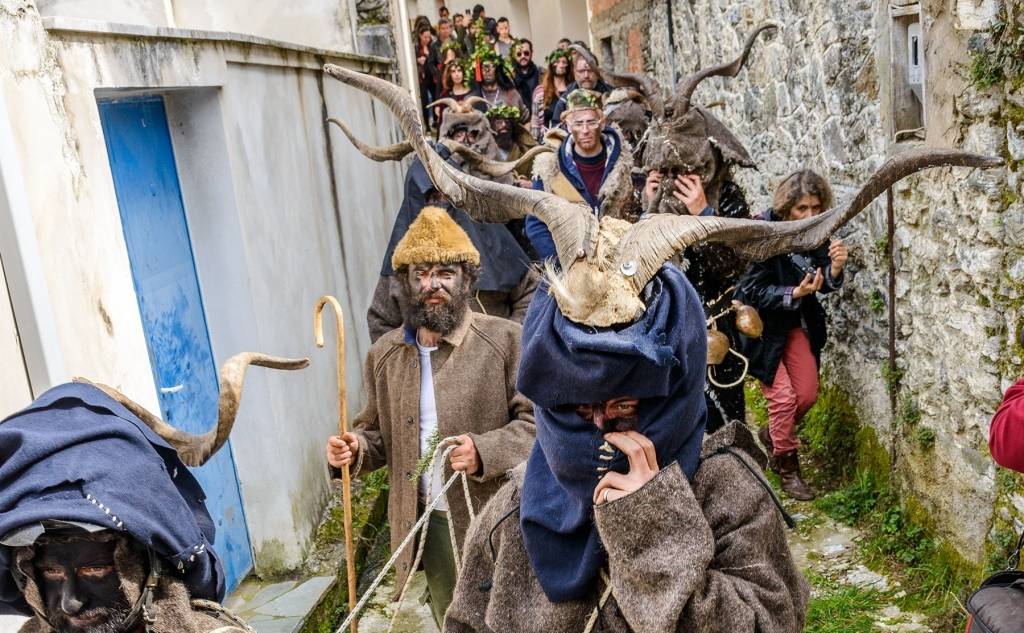







The green and picturesque village of Nedousa is built in the northwestern Taygetos at an altitude of 701 metres. It is 19 kilometres from Kalamata and has approximately 100 permanent residents. Until 1927, the village was called Megali Anastasova or Megali Anastasitsa. The original location of the settlement was different from the one found today in the Vythysmena area (near the church of Saint Varvara). This results mainly from the ancient, ruined buildings located there. The inhabitants were probably forced to leave this position due to the landslides.
During the Archaic period, the area was called Denthaliatis. The Denthaliatians were cheerful, unruly people, just like the current inhabitants of Nedousa. They worshipped the god Dionysus, cultivated vines and lived by agriculture and animal husbandry. Since then, the rural event of Nedousa, which takes place every year on the day of Clean Monday, has been preserved unchanged.
During the Greek Revolution of 1821, Nedousa played a crucial role since it was a refuge for many Greeks persecuted by Ibrahim. Also, the village is the birthplace of Nikitas Stamatelopoulos (1781-1849), known by the nickname "Nikitaras the Turkophagus". We know this from historian Georgios Tertsetis’ Memoirs, which were recorded. In the village, visitors can see his house, which was restored with respect to history and tradition. It is an initiative of the Cultural Association of Nedousa, in collaboration with private individuals and the Municipality and is, today, an ornament for Nedousa and Mount Taygetos. At this point, we should mention that the objects inside the house are all authentic from that time. Also, visitors can see the bust of the Greek fighter at the square.
The impressive single-arch bridge of Pantelikos, with an arch span of 12 metres and a height of 22 metres, dominates the village’s entrance. The high bridge was built in 1906 and is located between two characteristic stone-built watermills, one of which is the Anastasis Karabatsos’ watermill (known as the "Houftiaris" watermill).
Also, at a distance of only 3 kilometres from Nedousa, visitors can see the historic Monastery of Mardaki, whose catholicon is dedicated to the Dormition of the Virgin of "Chrysopigi". The monastery was stauropigian (patriarchal). It was built in the middle of the 17th century (1640-1645). Every year, it celebrates on the 15th and 23rd of August when the miraculous icon of the Virgin Mary is set for pilgrimage.
Of particular interest is "Chorigoskala", the place of heroism and sacrifice of twenty women of Moreas, who, refusing to fall into the hands of the Turkish-Egyptians, chose to fall with their children in their arms off the mountainous rocky and rugged location, at the end of May 1826. This episode of the Greek Revolution is mentioned as analogous to that of Zalongos in Epirus and Arapitsa in Naoussa, Macedonia. As a small tribute, Alagonia's people decided to bring to life the forgotten sacrifice of these women and children by creating a documentary under the title: "Chorgoskala, the path of sacrifice". Also, in May 2021, the unveiling of the monument took place under the rocks of Chorigoskala on the road to Nedousa. Messenian sculptor, Ioannis Gouzos, created the statue of the Greek woman fighter.
The parish church of Saint Catherine, which was founded between 1830 and 1840, dominates the centre of the village. North of the church is the square where the bust of the hero of the Revolution, Nikitas Stamatelopoulos, dominates the area, while to the south is the square where every year, on AshMonday, the age-old custom of the "Moutzourodeftera" carnival takes place. Also noteworthy are the stone chapels of the New Martyrs Raphael, Nikolaos and Irene, of the Holy Trinity, Agia Marina and Agios Georgios, and the unique chapel of Agios Stratigos, near the entrance of the village, built inside a cave.
For mountain sports lovers, in 2013, the Kalamata Mountaineering Association created the Nedousa Climbing Park, located in the gorge outside the village entrance. The Park has more than 50 routes with a degree of difficulty from 5 to 8. The area's climate and the fields' orientation allow climbing throughout the year, with the best times being spring and autumn.
Finally, every year, on Ash Monday, the village revives an authentic rural eveteria (prosperous harvest year) event (a kind of "folk theatre"), which consists of a series of acts and has its roots in the ancient Dionysian cult. In the Carnival of Nedusa (known as "Moutzourodeftera"), there are no organisers and spectators in the classical sense. Everyone participates equally in a century-old custom that endures over time.